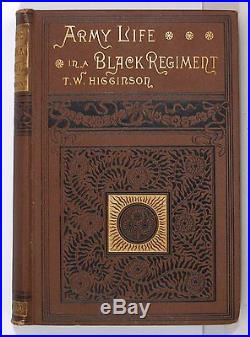1882 CIVIL WAR REGIMENTAL HISTORY OF 1st SOUTH CAROLINA COLORED TROOPS


Very Rare and historically important, 1882 2nd Edition of the Civil War, Union Regimental History of the First South Carolina Volunteers - composed of escaped slaves from South Carolina and Florida. The 1st South Carolina Volunteers was one of the first black regiments in the Union Army. This rare, original Volume is fully titled "Army Life in a Black Regiment". By Thomas Wentworth Higginson Late Colonel 1st South Carolina Volunteers. Published by Lee and Shepard.
This exceptionally rare and outstanding Civil War Regimental History measures approx. 5" by 7" and contains 296 pages including a full Index. Offered here is the first Regimental History of the first Civil War regiment comprised of freed Black Slaves. The First South Carolina Volunteers was composed of escaped slaves from South Carolina and Florida.
It was one of the first black regiments in the Union Army. The 54th Massachusetts Volunteer Infantry, whose exploits are memorialized in the film Glory, was formed afterwards and drew from free Northern blacks. Department of the South staff officer James D.
Fessenden was heavily involved in efforts to recruit volunteers for the 1st South Carolina. Although it saw some combat, the regiment was not involved in any of the war's major battles. Its first commander was Thomas Wentworth Higginson who wasas were all the other officerswhite. Higginson if the author of the Regimental History offered here. A proclamation by Confederate President Jefferson Davis had indicated that members of the regiment would not be treated as prisoners of war if taken in battle.The enlisted men would be auctioned off as slaves and the white officers were to be hanged. The threat was not carried out officially. The First South Carolina Volunteers was an initial step in the evolution of Union thinking towards the escaped slaves who crossed their lines. Next they were considered contraband and used as laborers. Finally the legal fiction that they were property was abandoned and they were allowed to enlist in the Army, although in segregated units commanded by white officers.
Harriet Tubman served with these men as a cook, nurse, spy, and scout. Susie King Taylor, whose husband and other relatives fought with the regiment, also served as a laundress and nurse for the men from August 1862 until mustering out on February 9, 1866. The men served as the precedent for the over 170,000 "colored" troops who followed them into the Union Army. Higginson, a minister, author and abolitionist, documented the Gullah dialect spoken by the men and made a record of the spirituals that they sang. Captain Seth Rogers was regimental surgeon and wrote extensive war time letters. His nephew, Captain James Seth Rogers, previously of the 51st Massachussettes, was captain of Company B. The regiment was re-designated the 33rd United States Colored Infantry Regiment on February 8, 1864. The existence of the First South Carolina Volunteers and the 54th Regiment Massachusetts Volunteers encouraged the formation of more Union Black regiments and eventually 180,000 black soldiers were serving in the Union army. One of the great source documents in human history, but one of our greatest Americans. In 1862 military necessity enabled Secretary of War Edwin M. Stanton to pry from a hesitant President Lincoln the authority to enlist black troops in the Union army. The pioneer regiment of ex-slaves was to secure the beachhead tenously held at Beaufort, off the South Carolina coast. Within a year, Lincoln was to hail the enlistment of black soldiers, which he had earlier resisted as "revolutionary, " as the heaviest blow yet dealt the rebellion.The abolition of slavery, unthinkable in 1861, was to be inevitable by 1863. The commanding officer chosen for the First South Carolina Volunteers was Thomas Wentworth Higginson, a militant human rights activist, writer and lecturer, and former Unitarian minister.
"In all the land, " writes the historian Ray Allen Billington, they could have found no one better for this assignment. Higginson was an excellent strategist and administrator who combined firmness with warmth and charm. Closely watched in the nation's press by both friends and foes of the undertaking, he soon shaped a first-class regiment. "Army Life in a Black Regiment" is Colonel Higginson's stirring account of his two years at Camp Saxton, recording the immediate effect of a decision that proved crucial to our survival as a nation and that ultimately shaped constitutional history. It is both a literary masterpiece and a unique historical document. This Volume is one of the rarest and most desirable of Civil War Regimental Histories. This exceptionally rare and historically important, Black regiment, Civil War Regimental History is in excellent++ condition. It is bound in its original gilt decorated, brown cloth covers which are in excellent condition - clean and crisp - tight and sound - exceptionally well preserved with light to the spine ends only. The gilt lettering on the spine and front cover is crisp and bold with no fading or wear. The interior pages are complete, tight and very clean throughout. Overall, this is an exceptionally well preserved example of this VERY rare Civil War Regimental History.An exceptionally rare, and highly sought after, Regimental History of the First South Carolina Volunteers and a fantastic addition to any Civil War Collection or Library!! The item "1882 CIVIL WAR REGIMENTAL HISTORY OF 1st SOUTH CAROLINA COLORED TROOPS" is in sale since Friday, May 13, 2016. This item is in the category "Collectibles\Militaria\Civil War (1861-65)\Original Period Items\Other Civil War Original Items".
The seller is "walnutts" and is located in Brewster, Massachusetts. This item can be shipped worldwide.
